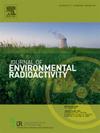Chemical analogues and probabilistic functions to derive distribution coefficients of radium in soils
IF 2.1
3区 环境科学与生态学
Q3 ENVIRONMENTAL SCIENCES
引用次数: 0
Abstract
The existing data gaps in the sorption and desorption parameters of naturally occurring radionuclides (e.g., radium (Ra)) challenge the use of radioecological risk assessment models. We present two alternatives for deriving Ra distribution coefficients (Kd (Ra)) in soils when the physicochemical information on the solid and liquid phases involved is too scarce to apply parametric prediction models: the deduction of sorption parameters from those of chemical analogues (such as Ba and Sr) and the proposal of best estimate Kd (Ra) values deduced from probabilistic distribution functions of data grouped according to relevant factors affecting Kd (Ra) variability. Regarding the use of chemical analogues, partial least squares regression analysis and univariate linear correlations revealed that Ba and Ra sorption in soils was governed by the same soil properties (Kd (Ca + Mg) and Mnam), related to exchangeable sites on the soil surface. The derivation of Kd (Ra) values from Kd (Ba) and also Kd (Sr) is feasible by applying suitable correction factors. Furthermore, several Kd (Ra) best estimates were derived from the distribution functions of Kd (Ra) datasets obtained from own and literature data. Statistical differences were noticed for the sorption and desorption datasets (the latter significantly affected by data from native Ra), leading to the proposal of distinct Kd (Ra) values (870 and 2760 L kg−1, respectively) for uptake and remobilisation scenarios. Regarding the desorption data, diverse Kd (Ra) best estimates were suggested for acidic (1540 L kg−1) and alkaline (6440 L kg-1) soils. For the sorption data, statistically different Kd (Ra) best estimates were suggested according to pH (100 and 1240 L kg−1 for pH < 4.5 and pH ≥ 7, respectively) and water-soluble Ca + Mg content, allowing for the selection of the most appropriate best estimate values for use in risk assessment models depending on the available information.

导出土壤中镭分布系数的化学类似物和概率函数
天然存在的放射性核素(例如镭(Ra))的吸收和解吸参数方面的现有数据缺口对使用放射性生态风险评估模型提出了挑战。当涉及固液相的物理化学信息过于稀缺而无法应用参数预测模型时,我们提出了两种方法来推导土壤中Ra分布系数(Kd (Ra)):从化学类似物(如Ba和Sr)的吸附参数中推导出Kd (Ra)值,以及根据影响Kd (Ra)变异性的相关因素分组数据的概率分布函数推导出最佳估计Kd (Ra)值。对于化学类似物的使用,偏最小二乘回归分析和单变量线性相关分析表明,土壤中Ba和Ra的吸收受相同的土壤性质(Kd (Ca + Mg)和Mnam)的控制,与土壤表面的交换位点有关。通过适当的校正因子,Kd (Ba)和Kd (Sr)可以推导出Kd (Ra)值。此外,从从自己和文献数据中获得的Kd (Ra)数据集的分布函数中得出了几个Kd (Ra)最佳估计。在吸附和解吸数据集上发现了统计差异(后者受到天然Ra数据的显著影响),从而提出了不同的Kd (Ra)值(分别为870和2760 L kg - 1)用于吸收和再活化情景。关于解吸数据,在酸性(1540 L kg-1)和碱性(6440 L kg-1)土壤中,Kd (Ra)的最佳估计是不同的。对于吸附数据,根据pH值(100和1240 L kg−1)提出了具有统计差异的Kd (Ra)最佳估计值;(分别为4.5和pH≥7)和水溶性Ca + Mg含量,允许根据现有信息选择最合适的最佳估估值用于风险评估模型。
本文章由计算机程序翻译,如有差异,请以英文原文为准。
求助全文
约1分钟内获得全文
求助全文
来源期刊

Journal of environmental radioactivity
环境科学-环境科学
CiteScore
4.70
自引率
13.00%
发文量
209
审稿时长
73 days
期刊介绍:
The Journal of Environmental Radioactivity provides a coherent international forum for publication of original research or review papers on any aspect of the occurrence of radioactivity in natural systems.
Relevant subject areas range from applications of environmental radionuclides as mechanistic or timescale tracers of natural processes to assessments of the radioecological or radiological effects of ambient radioactivity. Papers deal with naturally occurring nuclides or with those created and released by man through nuclear weapons manufacture and testing, energy production, fuel-cycle technology, etc. Reports on radioactivity in the oceans, sediments, rivers, lakes, groundwaters, soils, atmosphere and all divisions of the biosphere are welcomed, but these should not simply be of a monitoring nature unless the data are particularly innovative.
 求助内容:
求助内容: 应助结果提醒方式:
应助结果提醒方式:


